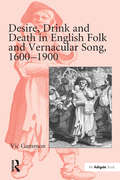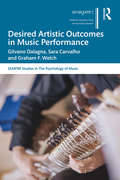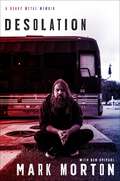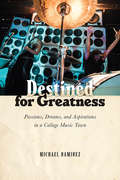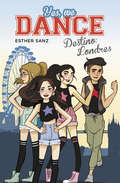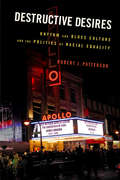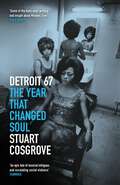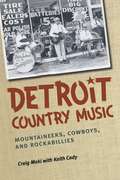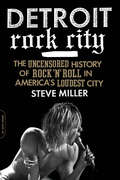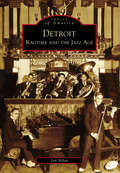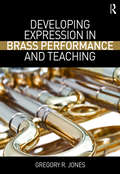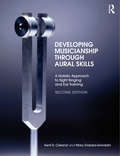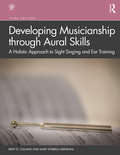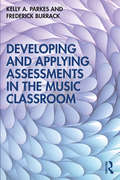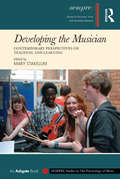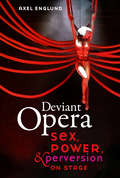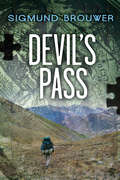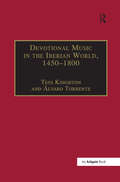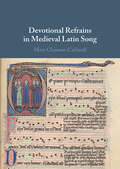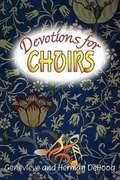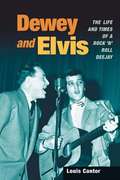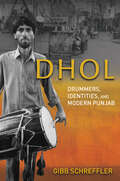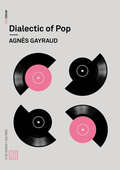- Table View
- List View
Desire and Pleasure in Seventeenth-Century Music
by Susan McclaryIn this book, Susan McClary examines the mechanisms through which seventeenth-century musicians simulated extreme affective states--desire, divine rapture, and ecstatic pleasure. She demonstrates how every major genre of the period, from opera to religious music to instrumental pieces based on dances, was part of this striving for heightened passions by performers and listeners. While she analyzes the social and historical reasons for the high value placed on expressive intensity in both secular and sacred music, and she also links desire and pleasure to the many technical innovations of the period. McClary shows how musicians--whether working within the contexts of the Reformation or Counter-Reformation, Absolutists courts or commercial enterprises in Venice--were able to manipulate known procedures to produce radically new ways of experiencing time and the Self.
Desire, Drink and Death in English Folk and Vernacular Song, 1600-1900
by Vic GammonThis much-needed book provides valuable insights into themes and genres in popular song in the period c. 1600-1900. In particular it is a study of popular ballads as they appeared on printed sheets and as they were recorded by folk song collectors. Vic Gammon displays his interest in the way song articulates aspects of popular mentality and he relates the discourse of the songs to social history. Gammon discusses the themes and narratives that run through genres of song material and how these are repeated and reworked through time. He argues that in spite of important social and economic changes, the period 1600-1850 had a significant cultural consistency and characteristic forms of popular musical and cultural expression. These only changed radically under the impact of industrialization and urbanization in the nineteenth century. The book will appeal to those interested in folk song, historical popular music (including church music), ballad literature, popular literature, popular culture, social history, anthropology and sociology.
Desired Artistic Outcomes in Music Performance (SEMPRE Studies in The Psychology of Music)
by Graham F. Welch Gilvano Dalagna Sara CarvalhoDesired Artistic Outcomes in Music Performance is about empowering musicians to achieve their professional and personal goals in music. The narrative argues that developing musicians should be supported in conceptualizing and achieving their desired artistic outcomes (DAO), as these have been recognized as key elements in a successful career transition in and beyond their studies in higher education. The text explores the nature of DAO and illustrates how higher education students can be enabled to explore and develop these. The book draws on the findings from a range of exploratory studies which: Bring to light connections between contemporary topics in music, such as artistic research and career development; Contribute to existing discussions on innovative pedagogical approaches in higher education in music; and Offer theoretical models to support the broad artistic and professional development in young musicians. This is a text grounded in theory and practice, and which draws on case study examples, as well as historical perspectives and coverage of contemporary issues regarding employment in the music industries. The book will be of particular interest to aspiring music professionals and all those working in the areas of Music Education, Performance Studies and Artistic Research.
Desolation: A Heavy Metal Memoir
by Mark MortonA gritty, revealing heavy metal memoir by Lamb of God&’s guitarist and lyricist, Mark Morton, which explores both his life in music and his tumultuous path through addiction and into recovery
Destined for Greatness: Passions, Dreams, and Aspirations in a College Music Town
by Michael RamirezPursuing the dream of a musical vocation—particularly in rock music—is typically regarded as an adolescent pipedream. Music is marked as an appropriate leisure activity, but one that should be discarded upon entering adulthood. How then do many men and women aspire to forge careers in music upon entering adulthood? In Destined for Greatness, sociologist Michael Ramirez examines the lives of forty-eight independent rock musicians who seek out such non-normative choices in a college town renowned for its music scene. He explores the rich life course trajectories of women and men to explore the extent to which pathways are structured to allow some, but not all, individuals to fashion careers in music worlds. Ramirez suggests a more nuanced understanding of factors that enable the pursuit of musical livelihoods well into adulthood.
Destino: Londres (Serie Yes, we dance #Volumen 2)
by Esther Sanz¡Acompaña a Martina, Sofía, Liu y Violeta en esta nueva aventura en el corazón de Londres! Martina y sus amigas viajan hasta la capital inglesa para participar en el maratón de baile que va a celebrarse en el Hyde Park. El grupo que salga ganador de esta competición será el que aparecerá en el nuevo videoclip del grupo del momento, los BB Brothers. No será nada fácil, pero las chicas lo tienen claro... ¡Están dispuestas a darlo todo!
Destructive Desires: Rhythm and Blues Culture and the Politics of Racial Equality
by Robert J. PattersonDespite rhythm and blues culture’s undeniable role in molding, reflecting, and reshaping black cultural production, consciousness, and politics, it has yet to receive the serious scholarly examination it deserves. Destructive Desires corrects this omission by analyzing how post-Civil Rights era rhythm and blues culture articulates competing and conflicting political, social, familial, and economic desires within and for African American communities. As an important form of black cultural production, rhythm and blues music helps us to understand black political and cultural desires and longings in light of neo-liberalism’s increased codification in America’s racial politics and policies since the 1970s. Robert J. Patterson provides a thorough analysis of four artists—Kenneth “Babyface” Edmonds, Adina Howard, Whitney Houston, and Toni Braxton—to examine black cultural longings by demonstrating how our reading of specific moments in their lives, careers, and performances serve as metacommentaries for broader issues in black culture and politics.
Detroit 67: The Year That Changed Soul (The Soul Trilogy #1)
by Stuart CosgroveFirst in the award-winning soul music trilogy—featuring Motown artists Diana Ross & the Supremes, Smokey Robinson, Marvin Gaye, and others. Detroit 67 is &“a dramatic account of twelve remarkable months in the Motor City&” during the year that changed everything (Sunday Mail). It takes you on a turbulent journey through the drama and chaos that ripped through the city in 1967 and tore it apart in personal, political, and interracial disputes. It is the story of Motown, the breakup of the Supremes, and the damaging clashes at the heart of the most successful African American music label ever. Set against a backdrop of urban riots, escalating war in Vietnam, and police corruption, the book weaves its way through a year when soul music came of age and the underground counterculture flourished. LSD arrived in the city with hallucinogenic power, and local guitar band MC5—self-styled holy barbarians of rock—went to war with mainstream America. A summer of street-level rebellion turned Detroit into one of the most notorious cities on earth, known for its unique creativity, its unpredictability, and self-lacerating crime rates. The year 1967 ended in social meltdown, rancor, and intense legal warfare as the complex threads that held Detroit together finally unraveled. &“A whole-hearted evocation of people and places,&” Detroit 67 is &“a tale set at a fulcrum of American social and cultural history&” (Independent).
Detroit Country Music: Mountaineers, Cowboys, And Rockabillies
by Craig Maki Keith CadyThe richness of Detroit’s music history has by now been well established. We know all about Motown, the MC5, and Iggy and the Stooges. We also know about the important part the Motor City has played in the history of jazz. But there are stories about the music of Detroit that remain untold. One of the lesser known but nonetheless fascinating histories is contained within Detroit’s country music roots. At last, Craig Maki and Keith Cady bring to light Detroit’s most important country and western and bluegrass stars, such as Chief Redbird, the York Brothers, and Roy Hall. Beyond the individuals, Maki and Cady also map out the labels, radio programs, and performance venues that sustained Detroit’s vibrant country and bluegrass music scene. In the process, Detroit Country Music examines how and why the city’s growth in the early twentieth century, particularly the southern migration tied to the auto industry, led to this vibrant roots music scene. This is the first book—the first resource of any kind—to tell the story of Detroit’s contributions to country music. Craig Maki and Keith Cady have spent two decades collecting music and images, and visiting veteran musicians to amass more than seventy interviews about country music in Detroit. Just as astounding as the book’s revelations are the photographs, most of which have never been published before. Detroit Country Music will be essential reading for music historians, record collectors, roots music fans, and Detroit music aficionados.
Detroit Rock City: The Uncensored History of Rock 'n' Roll in America's Loudest City
by Steve MillerDetroit Rock City is an oral history of Detroit and its music told by the people who were on the stage, in the clubs, the practice rooms, studios, and in the audience, blasting the music out and soaking it up, in every scene from 1967 to today.From fabled axe men like Ted Nugent, Dick Wagner, and James Williamson jump to Jack White, to pop flashes Suzi Quatro and Andrew W.K., to proto punkers Brother Wayne Kramer and Iggy Pop, Detroit slices the rest of the land with way more than its share of the Rock Pie.Detroit Rock City is the story that has never before been sprung, a frenzied and schooled account of both past and present, calling in the halcyon days of the Grande Ballroom and the Eastown Theater, where national acts who came thru were made to stand and deliver in the face of the always hard hitting local support acts. It moves on to the Michigan Palace, Bookies Club 870, City Club, Gold Dollar, and Magic Stick - all magical venues in America's top rock city.Detroit Rock City brings these worlds to life all from the guys and dolls who picked up a Strat and jammed it into our collective craniums. From those behind the scenes cats who promoted, cajoled, lost their shirts, and popped the platters to the punters who drove from everywhere, this is the book that gives life to Detroit's legend of loud.
Detroit: Ragtime and the Jazz Age
by Jon MilanDetroit has always been at the forefront of American popular music development, and the ragtime years and jazz age are no exception. The city's long history of diversity has served the region well, providing a fertile environment for creating and nurturing some of America's most distinctly indigenous music. With a focus on the people and places that made Detroit a major contributor to America's rich musical heritage, Detroit: Ragtime and the Jazz Age provides a unique photo journal of a period stretching from the Civil War to the diminishing years of the big bands in the early 1940s.
Developing Creativities in Higher Music Education: International Perspectives and Practices (Routledge Research in Higher Education)
by Pamela BurnardThis is the first book to critically address the issue of how we can enhance and develop creativities in higher music education. It features new international, richly diverse perspectives on the nature and practice of creativities in different cultural and institutional contexts, in varying roles and in response to diverse professional pressures and expectations of artistic and educational achievement. This compelling and provocative book combines powerful social and educational commentaries and examples drawn from international sources based on original practices and experience of a diversity of creativities. The authors provide an important contribution by drawing attention to what is at the heart of all music and how we can understand and foster these multiple creativities at an individual and institutional level. It features new analyses of the question of creativities in higher music education, and offers illustrative and innovative examples of adaptive learning environments for teaching and learning creatively, considering the broader issue of the role of creativities in relation to educational policy in the context of increasingly interventionist governments and rapidly paced educational change. Topics covered include: -the conceptual tools for people to think about and debate multiple creativities -the role of creativities in higher music education-how musicians can develop multiple creativities in new ways -new approaches to teaching and learning for multiple creativities -what constitute leadership creativities in conservatoires and music departments-creativities at the interface of institutional learning cultures-assessing the multiple creativities of music. Developing Creativities in Higher Music Education offers a multi-disciplinary research and practice focus, which will be essential reading for anyone involved in higher education and industry sectors. The book will appeal to academics and practitioners in music, researchers, instrumental and vocal teachers, curriculum and policy developers and institutional managers who want to enrich the higher education experiences of their students and enable them to develop more of their creative potential. It is also ideal reading for undergraduate and postgraduate students of music education who are looking for an authoritative selection of writings that define the fields of musical creativities in one comprehensive volume.
Developing Expression in Brass Performance and Teaching
by Gregory R. JonesDeveloping Expression in Brass Performance and Teaching helps university music teachers, high school band directors, private teachers, and students develop a vibrant and flexible approach to brass teaching and performance that keeps musical expression central to the learning process. Strategies for teaching both group and applied lessons will help instructors develop more expressive use of articulation, flexibility in sound production, and how to play with better intonation. The author shares strategies from today’s best brass instrument performers and teachers for developing creativity and making musical expression central to practicing and performing. These concepts presented are taken from over thirty years of experience with musicians like Wynton Marsalis, Barbara Butler, Charles Geyer, Donald Hunsberger, Leonard Candelaria, John Haynie, Bryan Goff, members of the Chicago Symphony and New York Philharmonic and from leading music schools such as the Eastman School of Music, The University of North Texas and The Florida State University.? The combination of philosophy, pedagogy, and common sense methods for learning will ignite both musicians and budding musicians to inspired teaching and playing.
Developing Musicianship Through Aural Skills: A Holistic Approach to Sight Singing and Ear Training
by Kent D. Cleland Mary Dobrea-GrindahlDeveloping Musicianship through Aural Skills, Second Edition, is a comprehensive method for learning to hear, sing, understand, and use the foundations of music as part of an integrated curriculum, incorporating both sight singing and ear training in one volume. Under the umbrella of musicianship, this textbook guides students to "hear what they see, and see what they hear," with a trained, discerning ear on both a musical and an aesthetic level. Key features of this new edition include: Revised organization, with exercises gradually progressing from the simple to more difficult, taking beginner students’ varied skill sets into account. An enhanced companion website, with interactive training modules for students to practice core skills, and additional exercises, dictation lesson plans and worksheets for instructors Enhanced coverage and a specific methodology for covering post-tonal material Greater emphasis on developing improvisation skills and realizing lead sheets The text reinforces both musicianship and theory in a systematic method, and its holistic approach provides students the skills necessary to incorporate professionalism, creativity, confidence, and performance preparation in their music education. The second edition of Developing Musicianship through Aural Skills provides a strong foundation for undergraduate music students and answers the need for combining skills in a more holistic, integrated music theory core.
Developing Musicianship through Aural Skills: A Holistic Approach to Sight Singing and Ear Training
by Kent D. Cleland Mary Dobrea-GrindahlDeveloping Musicianship through Aural Skills, Third Edition, is a comprehensive method for learning to hear, sing, understand, and use the foundations of music as part of an integrated curriculum, incorporating both sight singing and ear training in one volume. Under the umbrella of musicianship, this textbook guides students to "hear what they see, and see what they hear," with a trained, discerning ear on both a musical and an aesthetic level. Key features of this new edition include: Revised selection of musical examples, with added new examples including more excerpts from the literature, more part music, and examples at a wider range of levels, from easy to challenging New instructional material on dictation, phrase structure, hearing cadences, and reading lead sheets and Nashville number charts An updated website that now includes a comprehensive Teacher’s Guide with sample lesson plans, supplemental assignments, and test banks; instructional videos; and enhanced dictation exercises The text reinforces both musicianship and theory in a systematic method, and its holistic approach provides students the skills necessary to incorporate professionalism, creativity, confidence, and performance preparation in their music education. Over 1,600 musical examples represent a wide range of musical styles and genres, including classical, jazz, musical theatre, popular, and folk music. The third edition of Developing Musicianship through Aural Skills provides a strong foundation for undergraduate music students and answers the need for combining skills in a more holistic, integrated music theory core.
Developing and Applying Assessments in the Music Classroom
by Kelly A. Parkes Frederick BurrackDeveloping and Applying Assessments in the Music Classroom addresses the challenges faced by today’s K-12 educators and future music educators who are expected to utilize and incorporate assessment data as a hallmark of student learning and reflection of effective teaching. Highlighting best practices while presenting current scholarship and literature, this practical workbook-style text provides future music teachers with a framework for integrating assessment processes in the face of a certain lack of understanding and possible dissatisfaction with assessment tools and tasks. Each chapter is prefaced by an overview outlining learning expectations and essential questions, and supplemented throughout by an array of pedagogical features: Discussion prompts Activities and worksheets Learning experiences Expanded reference lists Citing examples across a range of musical settings—e.g. band, chorus, orchestra, jazz, and piano and guitar labs—Developing and Applying Assessments in the Music Classroom builds from the classroom assessment paradigm, encouraging teachers to create assessment tasks most appropriate to their curricula goals and planned student outcomes. Joined by fellow experts in the field Brian C. Wesolowski and Phillip Payne, the authors invite readers to explore and apply the material in authentic ways to inspire student learning through a comprehensive approach to educative assessment.
Developing the Musician: Contemporary Perspectives on Teaching and Learning (SEMPRE Studies in The Psychology of Music)
by Mary StakelumTo what extent does research on musical development impact on educational practices in school and the community? Do musicians from classical and popular traditions develop their identities in different ways? What do teachers and learners take into consideration when assessing progress? This book takes a fresh look at 'the musician' and what constitutes 'development' within the fields of music psychology and music education. In doing so, it explores the relationship between formative experiences and the development of the musician in a range of music education settings. It includes the perspectives of classroom teachers, popular musicians, classical musicians and music educators in higher education. Drawn from an international community of experienced educators and researchers, the contributors offer a range of approaches to research. From life history through classroom observation to content analysis, each section offers competing and complementary perspectives on contemporary practice. The book is an essential resource for musicians, educators, researchers and policy makers, offering insight into the reality of practice from those working within established traditions - such as the conservatoire and school settings - and from those who are currently emerging as significant forces in the fields of popular music education and community music.
Deviant Opera: Sex, Power, and Perversion on Stage
by Axel EnglundImagine Armida, Handel’s Saracen sorceress, performing her breakneck coloraturas in a black figure-hugging rubber dress, beating her insubordinate furies into submission with a cane, suspending a captive Rinaldo in chains from the ceiling of her dungeon. Mozart’s peasant girl Zerlina, meanwhile, is tying up and blindfolding her fiancé to seduce him out of his jealousy of Don Giovanni. And how about Wagner’s wizard, Klingsor, ensnaring his choir of flower maidens in elaborate Japanese rope bondage? Opera, it would appear, has developed a taste for sadomasochism. For decades now, radical stage directors have repeatedly dressed canonical operas—from Handel and Mozart to Wagner and Puccini, and beyond—in whips, chains, leather, and other regalia of SM and fetishism. Deviant Opera seeks to understand this phenomenon, approaching the contemporary visual code of perversion as a lens through which opera focuses and scrutinizes its own configurations of sex, gender, power, and violence. The emerging image is that of an art form that habitually plays with an eroticization of cruelty and humiliation, inviting its devotees to take sensual pleasure in the suffering of others. Ultimately, Deviant Opera argues that this species of opera fantasizes about breaking the boundaries of its own role-playing, and pushing its erotic power exchanges from the enacted to the actual.
Devil's Pass (Seven (the Series))
by Sigmund BrouwerSeventeen-year-old Webb's abusive stepfather has made it impossible for him to live at home, so Webb survives on the streets of Toronto by busking with his guitar and working as a dishwasher. When Webb's grandfather dies, his will stipulates that his grandsons fulfill specific requests. Webb's task takes him to the Canol Trail in Canada's Far North, where he finds out that there are much scarier things than the cold and the occasional grizzly bear. With a Native guide, two German tourists and his guitar for company, Webb is forced to confront terrible events in his grandfather's past and somehow deal with the pain and confusion of his own life.
Devotional Music in the Iberian World, 1450-1800: The Villancico and Related Genres
by TESS KNIGHTON AND ÁLVARO TORRENTEFrom the fifteenth century to the beginning of the nineteenth century, devotional music played a fundamental role in the Iberian world. Songs in the vernacular, usually referred to by the generic name of 'villancico', but including forms as varied as madrigals, ensaladas, tonos, cantatas or even oratorios, were regularly performed at many religious feasts in major churches, royal and private chapels, convents and in monasteries. These compositions appear to have progressively fulfilled or supplemented the role occupied by the Latin motet in other countries and, as they were often composed anew for each celebration, the surviving sources vastly outnumber those of Latin compositions; they can be counted in tens of thousands. The close relationship with secular genres, both musical, literary and performative, turned these compositions into a major vehicle for dissemination of vernacular styles throughout the Iberian world. This model of musical production was also cultivated in Portugal and rapidly exported to the Spanish and Portuguese colonies in America and Asia. In many cases, the villancico repertory represents the oldest surviving source of music produced in these regions, thus affording it a primary role in the construction of national identities. The sixteen essays in this volume explore the development of devotional music in the Iberian world in this period, providing the first broad-based survey of this important genre.
Devotional Refrains in Medieval Latin Song
by Mary Channen CaldwellThroughout medieval Europe, male and female religious communities attached to churches, abbeys, and schools participated in devotional music making outside of the chanted liturgy. Newly collating over 400 songs from primary sources, this book reveals the role of Latin refrains and refrain songs in the musical lives of religious communities by employing novel interdisciplinary and analytical approaches to the study of medieval song. Through interpretive frameworks focused on time and temporality, performance, memory, inscription, and language, each chapter offers an original perspective on how refrains were created, transmitted, and performed. Arguing for the Latin refrain's significance as a marker of form and meaning, this book identifies it as a tool that communities used to negotiate their lived experiences of liturgical and calendrical time; to confirm their communal identity and belonging to song communities; and to navigate relationships between Latin and vernacular song and dance that emerge within their multilingual contexts.
Devotions for Choirs
by Genevieve DehoogThese brief, easy-to-use devotions are ideal for use during choir rehearsal or before a choir program. Each devotion includes Scripture, devotional reflection, and a prayer.
Dewey and Elvis: The Life and Times of a Rock 'n' Roll Deejay
by Louis CantorBeginning in 1949, while Elvis Presley and Sun Records were still virtually unknown--and two full years before Alan Freed famously "discovered" rock 'n' roll--Dewey Phillips brought rock 'n' roll to the Memphis airwaves by playing Howlin' Wolf, B. B. King, and Muddy Waters on his nightly radio show Red, Hot and Blue. The mid-South's most popular white deejay, "Daddy-O-Dewey" is part of rock 'n' roll history for being the first major disc jockey to play Elvis Presley (and subsequently to conduct the first live, on-air interview with Elvis). This book illustrates Phillips's role in turning a huge white audience on to previously forbidden race music. His zeal for rhythm and blues legitimized the sound and set the stage for both Elvis's subsequent success and the rock 'n' roll revolution of the 1950s. Using personal interviews, documentary sources, and the oral history collections at the Center for Southern Folklore and the University of Memphis, Louis Cantor presents a very personal view of the disc jockey while arguing for his place as an essential part of rock 'n' roll history.
Dhol: Drummers, Identities, and Modern Punjab
by Gibb SchrefflerAn icon of global Punjabi culture, the dhol drum inspires an unbridled love for the instrument far beyond its application to regional vernacular music. Yet the identities of dhol players within their local communities and the broadly conceived Punjabi nation remain obscure. Gibb Schreffler draws on two decades of research to investigate dhol's place among the cultural formations within Punjabi communities. Analyzing the identities of musicians, Schreffler illuminates concepts of musical performance, looks at how these concepts help create or articulate Punjabi social structure, and explores identity construction at the intersections of ethnicity, class, and nationality in Punjab and the diaspora. As he shows, understanding the identities of dhol players is an ethical necessity that acknowledges their place in Punjabi cultural history and helps to repair their representation. An engaging and rich ethnography, Dhol reveals a beloved instrumental form and the musical and social practices of its overlooked performers.
Dialectic of Pop (Urbanomic: Mono #8)
by Agnes GayraudA philosophical exploration of pop music that reveals a rich, self-reflexive art form with unsuspected depths. In the first major philosophical treatise on the subject, Agnès Gayraud explores all the paradoxes of pop—its inauthentic authenticity, its mass production of emotion and personal resonance, its repetitive novelty, its precision engineering of seduction—and calls for pop (in its broadest sense, encompassing all genres of popular recorded music) to be recognized as a modern, technologically mediated art form to rank alongside cinema and photography. In a thoroughgoing engagement with Adorno's fierce critique of "standardized light popular music," Dialectic of Pop tracks the transformations of the pop form and its audience over the course of the twentieth century, from Hillbilly to Beyoncé, from Lead Belly to Drake. Inseparable from the materiality of its technical media, indifferent and intractable to the perspectives of high culture, pop subverts notions of authenticity and inauthenticity, original and copy, aura and commodity, medium and message. Gayraud demonstrates that, far from being the artless and trivial mass-produced pabulum denigrated by Adorno, pop is a rich, self-reflexive artform that recognises its own contradictions, incorporates its own productive negativity, and often flourishes by thinking "against itself."Dialectic of Pop sings the praises of pop as a constitutively impure form resulting from the encounter between industrial production and the human predilection for song, and diagnoses the prospects for twenty-first century pop as it continues to adapt to ever-changing technological mediations.

